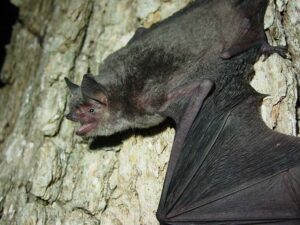Gray Bat

Adam Mann, Environmental Solutions and Innovations.
Scientific Name: Myotis grisescens
Description.
In the eastern US, gray bats is the largest bat within the genus Myotis. Weight ranges from 7 to 16 grams. Wingspan measures from 270 to 300 mm. A unique characteristic of gray bats are the lack of color bands instead a uniform fur color is seen, typically gray to reddish brown. Unlike related species, the gray bat’s wing membrane attaches to its ankle instead of the base of the first toe.
Distribution.
Gray bats have a broad, but patchy, distribution in southern parts of Midwestern states and the southeastern US. They mainly occur in Arkansas, Missouri, Kentucky, Tennessee, and Alabama, with colonies in neighboring states. Their occurrence in NC has been confirmed by captures in mist nets, as well as acoustically. However, there are no known gray bat roosts in North Carolina.
Ecology and Behavior.
Gray bats are true cave bats meaning they use caves both for hibernation and summer roosts, but do not alway return to the same cave each season. Hibernation requires very cold dave which limits the number of suitable caves resulting in 95% of all gray bats using only eight or nine caves for hibernation. Suitable summer cave roosts are also limited due to the need for very warm caves located near water. These habitat requirements mean that only 5% of the caves within their geographic range are suitable. This is reflected in their patchy distribution and contribute significantly to this species being listed with the US Fish and Wildlife Service Division of Endangered Species.
Food and Feeding.
Gray bats typically forage over, and fairly close to, water. Gray bats may be selective foragers with a preference for mayflies, but also feed on true flies, moths, and beetles.
Reproduction and Development.
Gray bats are not sexually mature until they are two years old. Mating occurs in the fall, just before hibernation. Fertilization, and therefore pregnancy, is delayed until the end of hibernation. A single pup is born in June and will be able to fly and forage on its own around three weeks later. The rate of development in gray bat pups is dependent on the temperature. Faster growth rates are seen in caves with warmer temperatures. Maternity colonies are formed by females and maintained until about two months after birth, when pups are fully weaned. At this time, individuals from the maternity colonies will begin roosting with bats that had spent summer in bachelor colonies, comprised of males and yearling bats of either sex.
Status.
Gray bats are very vulnerable because the vast majority of the total population uses only very few caves which contribute to their place on the US Fish and Wildlife Service Division Endangered Species List. Any disturbance to a summer or winter roost can be catastrophic. A disturbance to a summer maternity colony may result in the panicked mother dropping her nonvolant young. Disturbances during hibernation may cause excessive consumption of fat reserves, resulting in starvation. And, the presence of Pseudogymnoascus destructans, the fungus which causes white-nose syndrome in bats, was recently confirmed in hibernating gray bats
- Click here to see where you can find the Gray Bat in NC!
